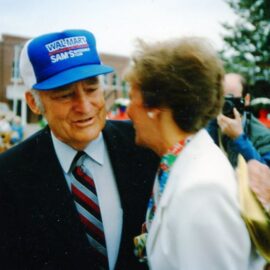

This article is an excerpt from the Shortform book guide to "The Ride of a Lifetime" by Bob Iger. Shortform has the world's best summaries and analyses of books you should be reading.
Like this article? Sign up for a free trial here .
Do you want to learn about former Disney CEO Bob Iger’s biography? How did a poor boy from Long Island become CEO of one of the world’s biggest media companies?
Bob Iger started as a bottom-level crew member on television sets and eventually became CEO of Disney for 15 years. He led Disney through momentous changes in technology and global expansion. This article is a brief overview of Bob Iger’s biography.
Continue reading for Bob Iger’s biography.
Bob Iger’s Biography
Bob Iger has had a long career—22 years at ABC, then 23 at Disney (after Disney acquired ABC). He started as a bottom-level crew member on television sets and eventually became CEO of Disney for 15 years. He led Disney through momentous changes in technology, global expansion, and its noted acquisitions of Pixar, Marvel, and Lucasfilm.
In Bob Iger’s biography, he looks back at his career in mild disbelief as an incredible, lucky ride of a lifetime.
Bob Iger’s Childhood
Bob Iger’s biography begins with his childhood. Bob Iger grew up working-class on Long Island, NY. He lived with his sister, younger by 3 years, his mother (a stay-at-home mom), and his father, a Navy veteran who flitted between advertising jobs. He never thought of their family as poor, but only as an adult did he realize how threadbare their finances were.
His father struggled with bipolar disorder and constantly viewed himself as a failure. Bob was determined not to end up like his father—Bob didn’t want to see his own life as failure—and he worked hard and strove to achieve. Through high school and college, he worked hard, determined to achieve some kind of success and escape disappointment. Throughout his career, Bob would have a habit of accepting every opportunity, even if he felt unprepared; he wanted to move up, learn more, and be capable of doing more things.
Bob’s Start in Television
Bob Iger’s biography continues after he graduates college. Iger worked for a year as a reporter and weatherman for a small Ithaca TV station. He’d once dreamed of becoming a big-time news anchorman, but his mediocrity at the job convinced him to try something else.
In 1973, at 23, he moved to Manhattan and got a job as a studio supervisor at ABC. It paid $150 per week and was the very bottom of the totem pole. His job was to do anything needed to get shows ready for airing, including showing up at 4:30 AM to let the stagehands onto the set, checking on catering, and keeping the staff happy however he could.
This was a pivotal experience for the young Bob Iger. He learned how shows of all kinds were made, from soap operas to news shows to game shows. He learned to work with all kinds of television staff, from makeup artists to electricians to carpenters. Most importantly, the grueling hours and workload developed a flinty work ethic that stays with him today.
Moving to ABC Sports
ABC Sports was a star department at ABC. They produced hit shows like Monday Night Football and Wide World of Sports, and they had exclusive coverage of the Olympics.
The president of ABC Sports was Roone Arledge, a legend in broadcasting. Roone changed sports broadcasting to focus on the human drama inherent in sports. He also embraced technology under his catchphrase, “innovate or die.”
Roone Arledge was also a perfectionist. He was unwilling to accept “good enough” and demanded greatness. He knew everything about his production and examined minute details, often requesting major overhauls the night before the broadcast. Roone also didn’t accept excuses—if you came to him saying something couldn’t be done, he’d push you to find another way.
Here Iger honed his own hunger for greatness and learned to question what could be possible. For instance, Iger led the first broadcast team into North Korea in decades to film a table tennis championship. The harsh State Department and US sanctions would have turned away anyone but Roone and the people who worked for him.
Acquired by Capital Cities, Moving Up
In 1985, Bob was 34 years old and, after spending 12 years at ABC, was a vice president at ABC Sports. That year, ABC was acquired by a company called Capital Cities Communication for $3.5 billion. This was an acquisition where a minnow swallowed a whale—ABC was four times as large as Capital Cities.
Capital Cities was run by two savvy business operators, Tom Murphy (CEO) and Dan Burke (COO). Despite their operational shrewdness, Tom and Dan were folksy, down-to-earth people who instilled admirable values in ABC: authenticity and low egos; respect and empathy to their staff; a decentralized management structure that gave business units autonomy.
Iger had a senior role in the 1988 Winter Olympics, and the success of that event caught Tom and Dan’s eye. A few weeks after the Olympics, Tom and Dan promoted Bob to executive vice president of ABC Television, the number two job at ABC TV.
This wasn’t the end—in 1989, Tom and Dan fired the head of ABC Entertainment and offered Iger the job. This was another big promotion—he’d be in charge of picking new primetime shows and become a major creative force in the company. Despite his hesitation that he didn’t know how to read scripts and pick good shows, Iger had a habit of saying yes to major opportunities, and he packed up his family and moved from New York to Los Angeles for the job.
Further Promotions
Iger’s success continued impressing Tom and Dan, and in 1993, Iger became the president of ABC at 43 years old. His rise through the ranks was dizzying. Just 8 years ago, he was still reporting to Roone Arledge; now Roone reported to him.
At the end of 1993, within a year of Iger’s taking the role, Tom shared that his COO Dan was retiring, and he needed someone as his number two. He wanted Iger to do it. Even though Iger habitually accepted every new opportunity, this was too fast—he needed to stabilize his work at ABC. Iger demurred, but Tom returned in 1994 and repeated his request. This time Bob accepted, and he became president and COO of Capital Cities/ABC.
Acquisition by Disney
In spring 1995, soon after Bob Iger became COO of Capital Cities/ABC, Disney made clear it wanted to acquire the company. Michael Eisner, who had been Disney CEO since 1984, led the charge.
What motivated the acquisition?
- Despite being one of America’s most storied brands, Disney was also feeling the pressure of a changing media industry. Fierce competition in entertainment was driving smaller companies to be acquired, like Time Inc.’s purchase of Warner and Viacom’s purchase of Paramount. If Disney wanted to remain independent, it would need to become larger.
- Furthermore, Disney was entering a creative funk. While the late ‘80s and early ‘90s saw smash hits like Aladdin and The Lion King, the mid-90s saw commercially lackluster films like Atlantis, Fantasia 2000, and Tarzan.
With ABC, Disney would expand its reach to audiences through ABC’s many media properties, including ABC, television stations, ESPN, cable channels, newspapers, and magazines. In return, Disney would benefit ABC with its famed creative forces and large catalog of content.
Ultimately, Iger agreed to a five-year contract as head of Disney media, and he couldn’t help dreaming about possibly one day running Disney. The deal closed in February 1996, with Disney paying $19.5 billion for Capital Cities/ABC.
Becoming COO of Disney
When Iger took the job, he angled to be Eisner’s number two and to be named company president, but Eisner deflected. Eisner was reluctant to name anyone to be president or COO, which stemmed from his insecurity about grooming a successor who would potentially compete with Eisner for the top job. For his part, Iger was ambitious and wanted a shot at running Disney one day, but he was also respectful and patient.
From 1996 to 1999, Iger’s responsibilities ranged from running ABC Group (which included ABC network and ESPN) and leading Disney’s effort into international expansion. His successes included laying the groundwork for Disney Shanghai; his failures included a slump for ABC, where lack of creative risk-taking led to being solidly third among networks.
By 1999, Eisner had been straining for years under the load of running Disney by himself, and he started thinking he needed a number two. He’d been CEO for 16 years, and the board was now pressuring him to plan for succession. At the end of the year, Eisner formally proposed that Iger become president, COO, and a member of the Disney board.
Iger Becomes CEO
In September 2004, Eisner announced to the board that he would step down in 2006 when his contract expired. The board accepted the offer and pushed the timeline faster—they would begin a search for the next CEO immediately and replace Eisner once they found the right person.
Iger was not the predestined successor to Eisner. In fact, given Disney’s decline, the board wanted a “change agent” from the outside. As Eisner’s number two for the past 4 years, and a lifelong ABC/Disney man, Iger simply looked like more of the same.
Iger knew he had to prepare a compelling vision of the future, and he focused on three priorities for Disney:
- Disney needed to make high-quality content. In an age where content was free and cheap, consumers would continue wanting to spend their time and money on great content. On the other hand, if Disney didn’t like Disney’s content, they wouldn’t visit their theme parks or buy Disney merchandise.
- Disney needed to embrace technology. Consumers had more choice than ever, and, to compete, Disney needed to make it easy for consumers to access their content and create high-quality experiences with technology. They needed to see technology as an opportunity and not a threat.
- Disney needed to become a global company. They had superficial reach throughout the world, but now they needed to penetrate each country, particularly China and India. This meant thinking about new products that would appeal to people they didn’t currently reach.
Iger had an uphill battle—most of the board members were against or lukewarm about his becoming CEO. But over the course of six months and fifteen interviews, Iger laid out his vision for the future and gradually swayed the swing voters on the board.
In March 2005, the board met to finalize their decision, and Iger got a call after they were done—Iger was to be the next CEO of Disney.
Iger’s Big Moves
Iger began by focusing on his first major priority—making high-quality content. From 2005 to 2012, Iger embarked on three major acquisitions of major media companies, each powerful storytelling brands with passionate fan bases.
- In 2006, Disney acquired Pixar, producer of animated films like Toy Story and A Bug’s Life, for $7.4 billion.
- In 2009, Disney acquired Marvel, the owner of a large catalog of superheroes, for $4 billion.
- In 2012, Disney acquired Lucasfilm, the owner of Star Wars, for $4.05 billion.
Each of the three acquisitions turned out to be home runs. They each produced blockbuster films that were adored by their fan bases and became global cultural phenomena. They restored Disney’s status to being a beloved brand and a leading storyteller. They also propelled Disney to new financial heights; once on the precipice of a downturn, Disney was now an entertainment juggernaut.
The Start of Streaming
By 2016, Disney had grown considerably, but the technology and media landscape had changed even further. The massive technology companies of the day—Google, Apple, Amazon, Facebook, Netflix—commanded the attention of billions of consumers. All these companies were also investing heavily in creating their own content.
In this climate, Disney had two choices. First, it could simply continue business as usual—it could continue distributing its content through movie theaters, TV, and distribution platforms like Netflix and Apple. However, Disney risked being made a commodity content producer, just one option among thousands. The tech behemoths would continue to gain power and consumer loyalty, and eventually Disney might have no choice but to be on these networks, meaning it’d lose all its negotiating leverage and lose its direct connection to consumers.
The other option was for Disney to control its own distribution to consumers, with no middlemen. This would require developing their own technology platform and severing ties with distributors like Netflix. It would also mean disrupting their own existing businesses in the short-term and losing hundreds of millions in revenue.
In this context, Disney chose the hard route of developing its own streaming services. It acquired the streaming technology company BAMTech and developed what would become Disney+ and ESPN+. At the same time, it took its beloved content off of competitors like Netflix. Now Disney held its destiny in its own hands.
Acquiring 21st Century Fox
Around August 2017, Rupert Murdoch approached Iger about the possibility of Disney’s buying 21st Century Fox, which housed the 20th Century Fox film studio, the Fox television network, and a bevy of other studios and cable channels.
The possibility was intriguing to Iger, but it would represent a deal possibly ten times bigger than Pixar’s $7 billion sale. It would be a company-defining decision.
Over the course of nineteen months, Disney pursued the acquisition of 21st Century Fox. It competed aggressively against rival Comcast, which made competing offers, and it fended off antitrust concerns about the deal. Ultimately, in March 2019, the deal completed—Disney bought 21st Century Fox for $71 billion. Disney was now one of the largest media entertainment companies in the world.
The Future of Disney
In 2019, when the book was published, Disney was at unprecedented heights. Avengers: Endgame became the highest-grossing movie of all time. The streaming service Disney+ launched with projections to gain ninety million subscribers within five years. It had made serious inroads in expanding globally through efforts like Disneyland Shanghai.
Fifteen years earlier, when vying for the CEO job, Iger had laid out a three-point plan—produce high-quality content, embrace technology, and become a global company. Now Iger could see that they had executed beyond their expectations, Disney had become an entertainment giant, and all the hard work was worth it.
Bob Iger’s biography really was the ride of a lifetime.

———End of Preview———
Like what you just read? Read the rest of the world's best book summary and analysis of Bob Iger's "The Ride of a Lifetime" at Shortform .
Here's what you'll find in our full The Ride of a Lifetime summary :
- How Bob Iger went from television crew member to CEO of Disney
- The 10 major principles behind Iger's management style and success
- How Iger resuscitated Disney Animation by buying Pixar






